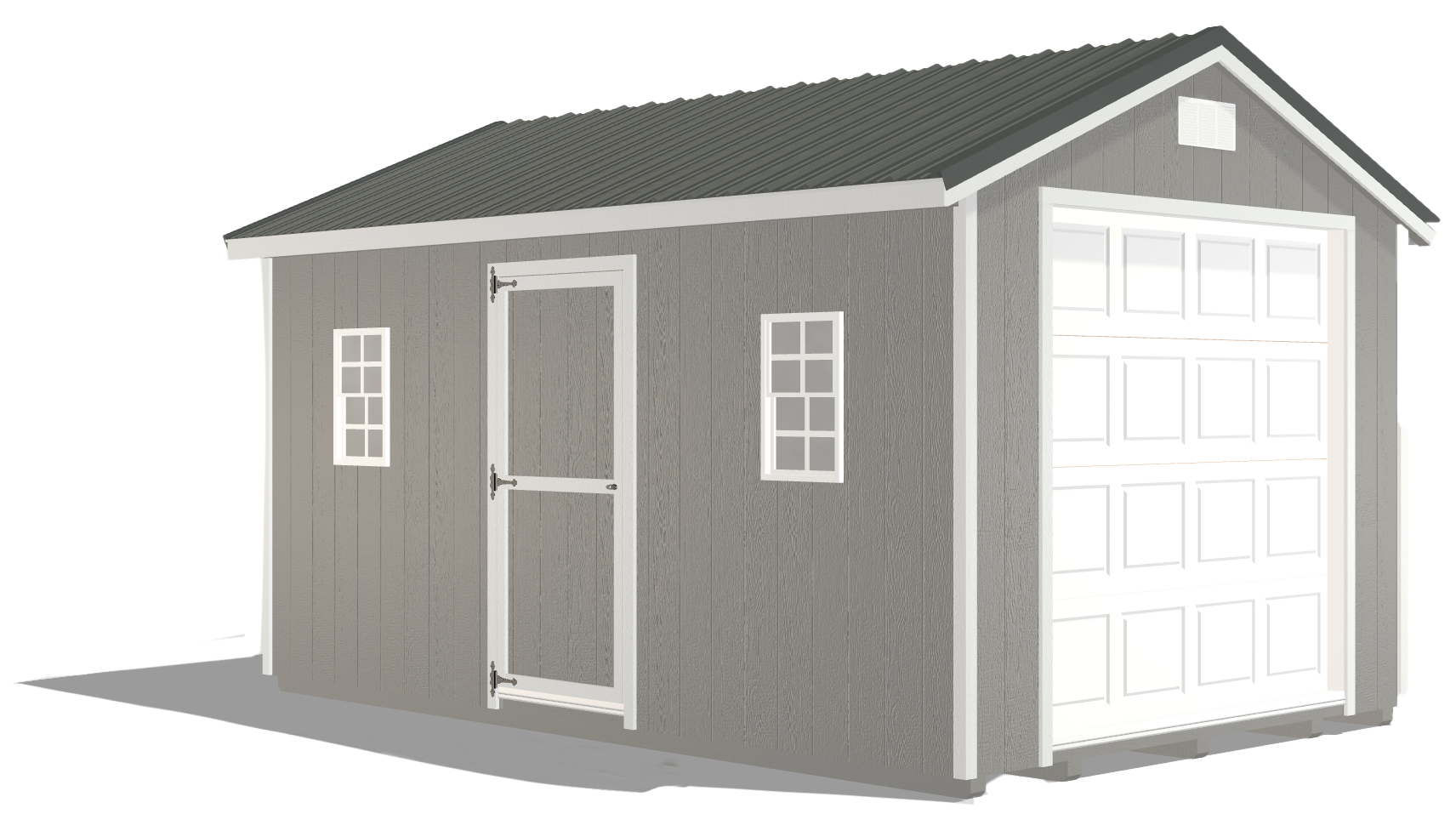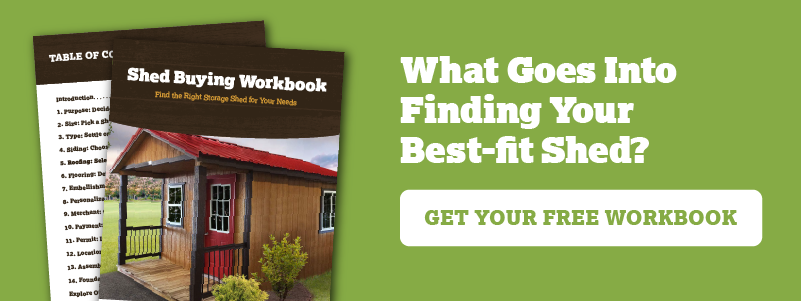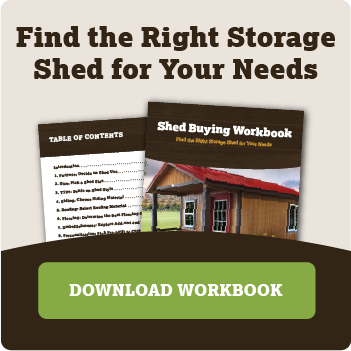What NOT to Store in an Outdoor Shed or Garage
by Dakota Storage Buildings, on July 24, 2024

Avoid Disaster By Keeping These Items Away From Storage Sheds
Outdoor storage sheds and garages are fantastic resources for keeping your items organized and out of sight. They offer a convenient way to increase your storage capacity by hundreds of square feet, making them an invaluable addition to any property. Whether you need extra space for seasonal equipment, outdoor gear, or overflow from your home, these structures can help declutter your living spaces and enhance the overall functionality of your environment. However, knowing what you should and should not store in an outdoor shed is crucial for protecting your belongings. Not all items are suited for the conditions typically found in outdoor storage areas. Keep reading to see the top 13 things you should not be storing in a shed or garage.
Maximize Your Space With an Outdoor Storage Shed
An outdoor storage shed can be an attractive addition to your outdoor decor and significantly boost your storage capabilities. What can you store in an outdoor shed? These structures are ideal for housing items that are too large or bulky for your home, such as ATVs, snowmobiles, motorcycles, boats, and other equipment. By keeping these items in an outdoor shed or garage, you free up valuable space inside your house while keeping your outdoor area tidy and organized. These storage solutions provide a dedicated space for seasonal items, gardening tools, and sports equipment, ensuring that your essential belongings are easily accessible when needed.
With the right design and placement, a small outdoor storage shed can also complement your landscaping, enhancing the overall aesthetic appeal of your property. Customizable options like shelving, workbenches, and lofts can maximize the utility of your shed, making it a versatile space that caters to all your storage needs. Whether you are looking to declutter your home, protect valuable outdoor equipment, or simply create a more organized living environment, investing in a well-designed storage shed or garage is a practical and efficient solution.
13 Items You Should Not Store in Your Outdoor Shed
While outdoor storage sheds are perfect for many items, certain belongings can be damaged by the conditions inside a shed. It's important to know which items are better kept indoors to ensure their longevity and functionality.
1. Food

Food, whether it’s perishable or not, should not be stored in a garage or shed. Fluctuations in temperature can cause food to spoil faster, and storing your food in outdoor-adjacent places can attract pests and rodents.
This goes for any food you’re going to feed any member of your family, furry and feathered friends included. Pet food and seeds should be stored indoors, not in a garage or shed.
According to the University of Minnesota, canned foods have a reduced shelf life in a room above 70°F. Most food degrades at 95°F. Furthermore, if your canned products freeze throughout the winter, they may be thawed, but the nutrition quality and taste may suffer.
Utah State University recommends against letting home-sealed cans or jars freeze.
“Freezing changes food textures, and leads to rust, bursting cans, and broken seals that may let in harmful bacteria,” they write. “Always store metal cans off of the floor, especially bare concrete. Moisture can wick up to cans and encourage rusting.”
Obviously, if you have a temperature-controlled solution, like the beloved Midwestern staple of a garage freezer, this advice may not be necessary. There are also ways to insulate a shed or garage to make the space more temperature-stable. But if your shed is not altered specifically to be temperature stable, keep any food items in your pantry.
2. Propane Tanks

Although sheds might seem like a safe place to store extra propane tanks since they are detached from the main house, it is actually not the best idea. Propane tanks stored in enclosed spaces like sheds can pose significant fire hazards. Even a small leak or spark can ignite the propane, leading to a potentially dangerous fire or explosion. It is crucial to store propane tanks in well-ventilated, open areas away from any structures to ensure safety.
The risks associated with storing propane in sheds include not only fire hazards but also potential gas buildup that can go unnoticed until it is too late. This can endanger anyone nearby and cause significant property damage. Always prioritize safety by keeping propane tanks in designated outdoor storage areas specifically designed to handle such materials, where proper ventilation and safety measures are in place.
3. Spare ATV Tires

Storing extra tires in unsteady conditions can lead to significant damage and deterioration. Cold temperatures can cause the rubber to freeze, making it brittle and prone to cracking. Prolonged exposure to heat can result in dry rot, weakening the tire's structural integrity. Additionally, moisture can accelerate wear and tear, reducing the lifespan of your tires.
To protect your investment, it is best to store tires in a climate-controlled environment, such as a basement away from heat sources or a specialized storage unit. These environments provide stable conditions that prevent freezing, overheating, and moisture buildup, ensuring your tires remain in optimal condition for longer. Proper storage not only preserves the quality and safety of your tires but also maximizes their longevity, saving you money in the long run.
4. Musical Instruments

Depending on the material, musical instruments can be harmed by heat or moisture. Wood, for example, is greatly influenced by both. Brass instruments can rust when exposed to moisture or humidity, therefore keep humidity management in mind when storing them. Sheds are not appropriate for keeping any musical instruments that you want to preserve in good condition.
According to TheStrad.com, excessive humidity can weaken glue connections and soften the wood, exposing the instrument to irreversible deformation. The neck becomes prone to bending, which can result in diminished neck projection, elevated strings, and fingerboard depression. It is critical to keep equipment in a regulated environment that does not change by the weather.
5. Artwork

Because artwork is sensitive to both heat and moisture, it requires temperature and humidity management. Expansion and contraction can cause warping, while moisture can lead to mold growth. High heat and sun exposure can cause discoloration. Furthermore, variations in temperature and humidity can cause paint to flake and fracture, as well as the canvas to expand and compress. Keep artwork in a stable and regulated atmosphere for long-term storage.
Do you want to properly preserve your artwork? In their article "How to Pack Your Artwork for Long-Term Storage," HomeGuides.com provides excellent recommendations.
6. Cans of Paint

Paint, refinishing solvents, and stains that are stored in a shed or garage frequently deteriorate. Small outdoor storage sheds or garages, can be troublesome because they can get too chilly in the winter, too hot in the summer, and may have moisture issues.
Extreme temperatures may wreak havoc on the remaining paint. Some paints split, leaving a curdled, useless mess behind. Keep in mind that paint cans left on a cement floor and exposed to moisture can soon corrode. A better location to keep paint is on a shelf in your basement.
7. Electronics

Electronics such as microwaves, phones, and laptops can be harmed when stored in a shed or garage. Storing electronics in a shed can pose significant risks due to temperature extremes, humidity, and potential pest damage.
Risk of Temperature Extremes: Fluctuations in temperature can cause batteries to leak or even explode. Extreme cold or heat can damage electronic components and long exposure to high temperatures can render sensitive materials inside electronics unusable.
Humidity and Moisture Concerns: High humidity levels can lead to corrosion of battery terminals and electronic circuits, causing malfunctions or significantly reducing the lifespan of your electronics. Moisture can seep into devices, causing short circuits and irreversible damage to delicate parts.
Pest and Rodent Damage: Rodents and pests might nest in your outdoor shed and chew on wires or battery casings, leading to short circuits or electrical hazards. These animals are attracted to the warmth and shelter provided by electronics, and their activity can result in significant damage that is both hazardous and costly to repair.
8. Things in Cardboard Boxes

If you're planning to keep your possessions outside in a shed, don't put them in cardboard boxes. This includes seasonal décor (yes, your Christmas decorations, too! ), outgrown apparel, and keepsakes. Insects, vermin, mold, and water or moisture damage are always a risk when storing items in cardboard boxes. Choose waterproof, pest-proof plastic containers over cardboard, especially if you want to keep garments in a shed.
Large plastic storage tubs often go on sale around the holidays, so you can even have Halloween-colored tubs for your Halloween decorations and red and green storage solutions for your Christmas ornaments.
9. Books and Paper Goods

Storing books and other paper items in environments susceptible to humidity can lead to significant damage over time. The pages of books can become stuck together, making them difficult to separate without tearing. Additionally, certain pests, such as silverfish, are attracted to the paper and the glue used in book bindings. Silverfish thrive in dark, damp environments, making sheds an ideal habitat for them. These insects can cause considerable damage, eating away at the paper and weakening the structure of the book. As they feed on the paper and glue, they leave behind irregular holes and damage that can render books unreadable.
To prevent this, it is crucial to store books and other valuable paper items in a controlled environment where humidity and temperature levels are stable. Using protective measures such as airtight containers can help preserve these items and prevent damage from pests and moisture.
10. Photos

Physical photos can suffer from humidity damage, leading to warping, fading, and eventual destruction. The delicate emulsion layer on photo prints is particularly vulnerable to moisture, which can cause colors to bleed and images to distort. Moisture and high temperatures can also cause beloved photographs to clump together and even develop mold. Insects and rodents can also pose a threat, potentially nibbling on the edges or creating nests among your stored items.
Since these items are often irreplaceable and hold sentimental value, it is best to store them in a controlled indoor environment where temperature and humidity levels are stable, and pests are less likely to cause damage. A great solution is to store photos in a closet within your home. Trust us, you do not want to discover that your precious memories are stuck together and ruined because they got wet.
11. Important Documents

Important documents like social security cards, passports, and birth and marriage certificates should be stored in a waterproof and fireproof safe. Keeping this safe in your home office or bedroom is much more secure than placing it in your backyard shed, where it is more vulnerable to damage and theft. Documents stored in a shed are susceptible to moisture, which can ruin paper materials, making them unreadable and unusable. Additionally, a home office provides easier access when you need these important documents quickly.
Even with security measures like strong locks and outdoor lighting, someone might still break into your shed. Discovering a safe inside would immediately signal to them that it contains valuable items, increasing the risk of theft. Safes in sheds are also more likely to experience temperature fluctuations, which can affect their integrity over time. By keeping your safe in a more controlled indoor environment, you ensure the longevity and safety of your critical documents.
12. Pool Chemicals

Backyard sheds often experience significant changes in humidity, especially during rainy weather, which can affect the storage of pool maintenance chemicals like water balancers and chlorine in their powdered, granular, or tablet forms. These substances are highly sensitive to moisture, which can lead to deterioration, clumping, and reduced effectiveness.
Insufficient airflow in sheds can cause the accumulation of chemical fumes, posing health and safety risks. These fumes can also lead to the corrosion of tools, equipment, and other metal items stored within the shed, necessitating increased maintenance and potential replacement costs. Proper ventilation and alternative storage solutions for these chemicals are essential to prevent these issues and maintain a safe, functional storage environment.
Furniture or Upholstered Items

Solid wood furniture and items wrapped in leather or fabric upholstery should not be stored in an outdoor shed. While it might seem convenient to store extra furniture outdoors, the climate inside a shed can cause significant damage.
Wood: Heat and humidity can cause wood to warp, compromising the structural integrity and appearance of your furniture. Over time, this warping can lead to joints becoming loose, making the furniture unstable and unsafe to use.
Leather: Leather items are particularly susceptible to cracking and deterioration when exposed to fluctuating temperatures and humidity levels. The material can dry out, lose its flexibility, and develop unattractive cracks and tears, significantly reducing its lifespan and aesthetic appeal.
Fabric Upholstery: Fabric-covered items are prone to mold and mildew, which can ruin the material and create health hazards. The fabric can absorb moisture, leading to unpleasant odors and potential structural damage to the underlying materials. For these reasons, it is best to store furniture and upholstered items in a controlled indoor environment.
Note: SOME of These Items CAN BE Stored in Your Shed or Garage IF...
If you choose to add shed insulation, humidity control, and an apparatus to regulate temperature, you can make your outside shed or garage a satisfactory place to store almost anything (except important, legal, or personal documents!).
High-quality shed insulation and a thermostat can stabilize the temperature in your shed and, often, the humidity. If more humidity control is needed, bringing in a small dehumidifier might do the trick.
So, what can you store in a normal, non-insulated, non-temperature controlled shed or garage? A lot. This post covered what you definitely should not store, but there's so much that you can store. Doing so frees up space in your house, makes access to lawn & garden tools and equipment more convenient, and protects all your outdoor recreation items — like bikes — from the elements. For quick reference, here's our list of items that can absolutely be stored in your shed.
Make the Most of Your Shed Space
Now that you understand what should not be stored in your outdoor shed, you can make informed decisions to protect your valuable items. For more detailed guidance and additional resources, download our Shed Buying Workbook. This comprehensive guide will help you maximize the potential of your storage shed, ensuring that your belongings are safe and well-organized. With the right knowledge and tools, you can transform your outdoor storage shed into a highly functional space that complements your outdoor area. Start your journey toward a clutter-free, efficient storage solution today and enjoy the benefits of an organized and well-maintained shed.
More articles:

























